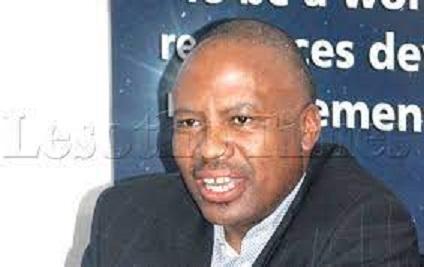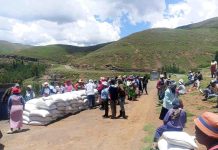Africa-Press – Lesotho. A FORTNIGHT ago, the Lesotho Highlands Development Authority (LHDA) awarded WRES Senqu Bridge Joint Venture a massive M2 billion contract for the construction of the Senqu Bridge under Phase II of the Lesotho Highlands Water Project (LHWP II).
The LHDA is the implementing authority of the LHWP II. This is a multi-phased project aimed at providing water to South Africa’s Gauteng province as well as generating hydro-electricity for Lesotho.
It was established by the 1986 Treaty signed by the governments of Lesotho and South Africa. The project entails harnessing the waters of the Senqu/Orange River in the Lesotho highlands through the construction of a series of dams for the mutual benefit of the two countries.
Phase I of the LHWP, consisting of the Katse and Mohale dams, the ‘Muela hydropower station and associated tunnels was completed in 2003 and inaugurated in 2004. Phase II is currently in progress.
The water transfer component of Phase II comprises an approximately 165m high concrete faced rock fill Dam at Polihali downstream of the confluence of the Khubelu and Senqu (Orange) Rivers and an approximately 38km long concrete-lined gravity tunnel connecting the Polihali reservoir to the Katse reservoir.
Other Phase II activities include advance infrastructure (roads, accommodation, power lines and telecommunication) and the implementation of environmental and social mitigation measures.
Lesotho Times (LT) Editor Herbert Moyo caught up with LHDA chief executive Tente Tente in the wake of the awarding of the huge M2 billion tender for the construction of the Senqu Bridge.
In the interview below, Mr Tente talks up the massive economic and social benefits that are set to accrue to Lesotho due to the LHWP II. Excerpts: LT: A fortnight ago the LHDA awarded WRES Senqu Bridge Joint Venture a massive M2 billion contract for the construction of the Senqu Bridge as part of the LHWP II.
Please tell us more about this tender. Which other tenders have been awarded so far? Tente: The Senqu Bridge tender is the biggest construction tender awarded to date. This will be the largest of the three bridges that will be constructed under Phase II to span the Polihali reservoir.
The winning joint venture comprises of Lesotho, South African and international companies as per the requirements of the Phase II agreement between Lesotho and South Africa.
The primary partners are: Webuild S. p. A. (from Italy); Raubex Construction (Pty) Ltd (South Africa); Enza Construction (Pty) Ltd (South Africa) and Sigma Construction (Pty) Ltd (Lesotho).
The sub-contractors are: EXR Construction (Pty) Ltd (South Africa; Gleitbau-Geselschaft (Austria); Post Tensioning and Structural Solutions (Pty) Ltd (South Africa) and Freyssinet International et Cie (France).
The Senqu Bridge tender precedes the tenders for the main water transfer components of Phase II – Polihali Dam and the Polihali Transfer Tunnel and the other two major bridges: the Mabunyaneng and Khubelu bridges, which will be among the larger tenders.
Fifty-five Phase II contracts have been awarded since the start of procurement in 2015. Of these, 13 are construction contracts for the advance infrastructure works.
LT: All this time, the talk has centred on the pre-construction works of access roads, bridges among others. How far are you with the pre-construction works? When are these projected to be completed?
Tente: Significant progress has been made on the advance infrastructure which is expected to be completed in the 2022/2023 financial year. Key milestones include: Polihali diversion tunnels
Although a component of the Phase II main works, the two diversion tunnels were constructed as part of the advance infrastructure in preparation for the Polihali Dam construction and ahead of the appointment of the dam contractor.
The Lesotho Highlands Development Authority (LHDA) celebrated the double breakthrough of the tunnels in August 2021 marking the completion of 1870 meters of excavation.
Excavation inside the two Polihali diversion tunnels commenced in June 2020 and mostly advanced from the outlets. Construction was completed in November 2021.
The contractor and consultant have demobilised from site and the one-year Defects Notification Period commenced on 26 November 2021. The first quarterly defects inspection of the diversion tunnels took place in early March 2022. Bulk power
The electrical infrastructure required for the Phase II development includes the construction of new substations, upgrading of existing Lesotho Electricity Company (LEC) substations, the construction of new power lines and the diversion of the existing LEC 33kV distribution network between Letšeng and Mokhotlong that is below the Polihali Dam full supply level.
A 33kV power line of 2, 2 kilometres from Tlokoeng to Polihali to supply early power for the advance infrastructure contracts and the Polihali village prior to the completion of the main power from Matsoku was completed in June 2021.
The construction of a 132kV38km transmission line between Matsoku substation and the new substation at Polihali have been completed and both were energised in mid-January 2022.
Telecommunications The telecommunications work will provide high speed communication within LHWP sites ensuring reliable connectivity on all LHDA sites and between the Mabote command centre. The work on the telecommunications infrastructure commenced in April 2022. Completion date is June 2023. Polihali and Katse infrastructure works
The works at Polihali and Katse including the potable water supply system and sewer reticulation to permanent and temporary residential areas, water treatment facilities, access roads and street lighting are complete.
Housing and accommodation Construction is underway on the Katse Lodge and Katse Village upgrades, the Polihali Village and Polihali Operations Centre.
These are three of the four Phase II housing contracts packaged to enhance local participation especially of small- and medium-sized contractors. Procurement is advanced on the remaining tender for the construction of the Polihali Commercial Centre.
Access roads Construction of the Polihali Western Access Road (PWAR) East and West, Polihali North East Access Road (PNEAR) and the Northern Access Road is progressing well but is behind schedule.
Heavy rainfall and community complaints have exacerbated slow construction progress. LT: The timeline for the actual construction of the proposed Polihali Dam has seemingly been shifting over time.
When do you expect the actual construction to begin? Has the tender for the actual dam construction been awarded? If so, to who? If not, when do you think it will be done?
Tente: The Polihali Dam construction is under procurement and this procurement is expected to be completed in 2022 heralding the start of construction thereafter.
Impoundment is expected in 2025 and water delivery is expected to commence in 2028 according to the current master programme. LT: So many figures have been thrown around in terms of what the LHWP II project will cost.
There has been talk that delays in actual construction have caused the budget to balloon astronomically by billions of Rands/Maloti. What is your estimate of the total cost?
Tente: The estimated cost at completion in 2028 is M37 billion. This includes escalation and contingency. LT: When is the LHWP II project likely to be completed? Tente: The water transfer component of the project is expected to be fully completed in 2029.
According to the current master programme, the first stage of the reservoir impoundment is expected in 2025, completion of the dam and tunnel are expected in 2028 and water delivery is expected to commence in 2028.
In December 2021 the Lesotho government confirmed the Oxbow Hydropower Scheme as the preferred hydropower option for Phase II. The procurement of a service provider for the detailed design and supervision for this component is underway.
LT: Much of the talk has centred on the pre-construction infrastructure and the construction of the proposed dam itself. Please give us an overview of other ancillary projects that you are involved in for the benefit of communities around the Polihali area?
Tente: To mitigate the impact of Phase II on the lives, livelihoods and socio-economic status of communities in the Project area the LHDA is effecting a number of programmes.
Besides compensating affected households and communities for lost assets and carefully planned resettlement, these include livelihoods restoration programmes, a public health programme and skills transfer programme.
Each of these includes extensive stakeholder and community engagement and takes into account the terms of the Phase II Agreement, lessons learned from the implementation Phase I of the LHWP and communities’ concerns.
The livelihoods restoration programme includes facilitating financial literacy and livelihood options awareness workshops, agricultural demonstration projects like the Ha Mojakisane communal garden, enterprise and food preservation training, trades skills training and accreditation in collaboration with the Ministry of Education through the department of Technical and Vocational Training.
Recent highlights include: Skills accreditation In early March, the Lesotho Highlands Development Authority (LHDA) and the Ministry of Education through the department of Technical and Vocational Education (TVE), began the skills testing programme for over 400 builders from the Seate and Menoaneng Community Councils in the Mokhotlong district.
The programme is designed to test and accredit the technical skills of people in the Phase II project area who have building skills and experience but lack the certification to support their entry into the job market.
In early April, at a graduation ceremony held at the Mapholaneng Resource Centre, a total of 213 of the 230 bricklayers tested received certificates validating their skills.
In August, 184 local builders in the Menoaneng Community Council received certificates for their stone and bricklaying skills. Skills testing for other technical skills such as carpentry and plastering will also be implemented in the months ahead.
The Trades Testing and Accreditation Programme, which is expected to be completed in November 2022, is part of LHDA’s commitment to promoting wage-based livelihoods and opportunities for self-employment as part of the livelihoods restoration programme which aims to mitigate the impact of Phase II on local communities.
Livelihoods awareness We have several sessions in several electoral divisions in the Project area to raise awareness on financial products and services, agricultural development support services and small- and medium-scale enterprises support services.
The sessions targeted households whose assets will be affected by reservoir inundation particularly but were also open to other non-affected households.
The meetings were facilitated by institutions with a presence in Mokhotlong; commercial banks, insurance companies, mobile network operators, the Mokhotlong Farmers’ Forum and the Smallholder Agricultural Development Project, and the Basotho Enterprises Development Corporation.
The main objective of the Phase II livelihoods awareness programme is to afford affected households an opportunity to engage with relevant organisations to enable them to make informed decisions about alternative livelihood options and sustainable management of their compensation funds.
Public health A Public Health consultant has been engaged to manage the implementation of the Public Health Action Plan (PHAP) developed by the LHDA to mitigate the project health impacts on the affected communities.
The PHAP focuses on five mitigation strategies: Community Outreach Programme which includes school health and health education programmes, capacity building of health care professionals, augmentation of the Health Management Information System (HMIS), infrastructure development through the construction of health posts, renovation of Mokhotlong Hospital and the provision of medical equipment, and lastly through interaction with other consultants in the implementation of Livelihood Restoration and Social Development Programme.
The outreach programme has commenced and the training of health care professionals is ongoing. LT: Compensation for affected/displaced villagers has always been a topical issue.
Please give us an overview of the measures that you have taken in this regard. How many have you paid out and to how many families? Tente: Details pertaining to compensation payments to households are confidential and cannot be disclosed.
However, the LHDA can confirm that at the end of the 2021 financial year, the registration and verification of affected assets had been largely completed for the current project components, with the exception of graves in the reservoir inundation area.
The re-engineering of key modules of the computerised compensation system had been completed and asset registration and compensation processes had been streamlined.
Resettlement planning and implementation had progressed well. The layouts for five relocation sites had been completed and tender designs for the first three had been prepared in preparation for contractor procurement.
The Polihali Operations Branch is supervising the construction of nine replacement dwellings for households affected by the Polihali North-East and Polihali Western access roads and bulk power developments.
It is also important to note that the compensation process is not simultaneous for all people affected by the Project. It is dealt with on an area by area basis as assets are required for the implementation of the Project.
LT: Much of the talk has focused on the likely benefits of the project in terms of water for South Africa and electricity and royalties for Lesotho. You have alluded to the potential for other benefits such as tourism opportunities.
Please outline how the project will benefit tourism and what are the other potential benefits of the LHWP II for Lesotho? Tente: Lesotho’s tourism industry has grown since the implementation of Phase I. Large numbers of local and international tourists have visited the Project sites.
Besides the increased tourism potential, increased royalties on the water transferred to South Africa and reducing Lesotho’s dependence on imported electricity, saving on electricity import costs and contributing to the country’s Gross Domestic Product (GDP) by stimulating local industry and economic growth, Phase II will benefit Lesotho in a number of ways: from the high quality infrastructure built in Lesotho, including roads, power lines, telecommunications, buildings and tourist facilities; the employment of a significant proportion of people working on the project during and after construction; business opportunities during and after construction in terms of supplying materials and services for consultants and contractors; training and skills development for Basotho; the development of Basotho professional firms e. g. engineers, environmental and social consultants and increased tax revenues.
For More News And Analysis About Lesotho Follow Africa-Press






